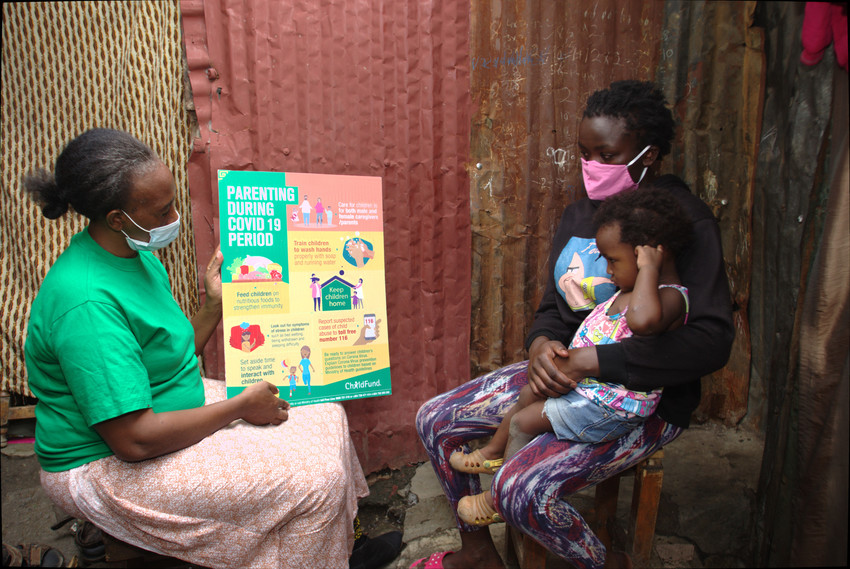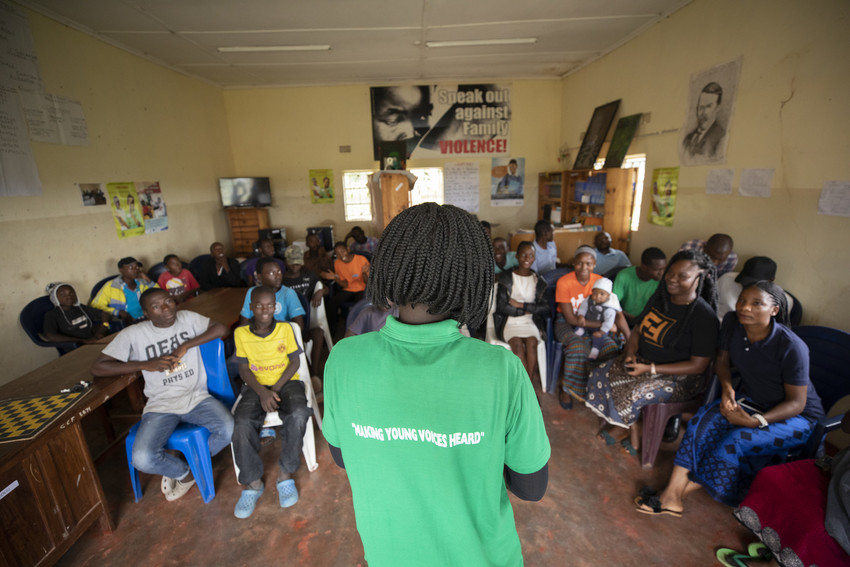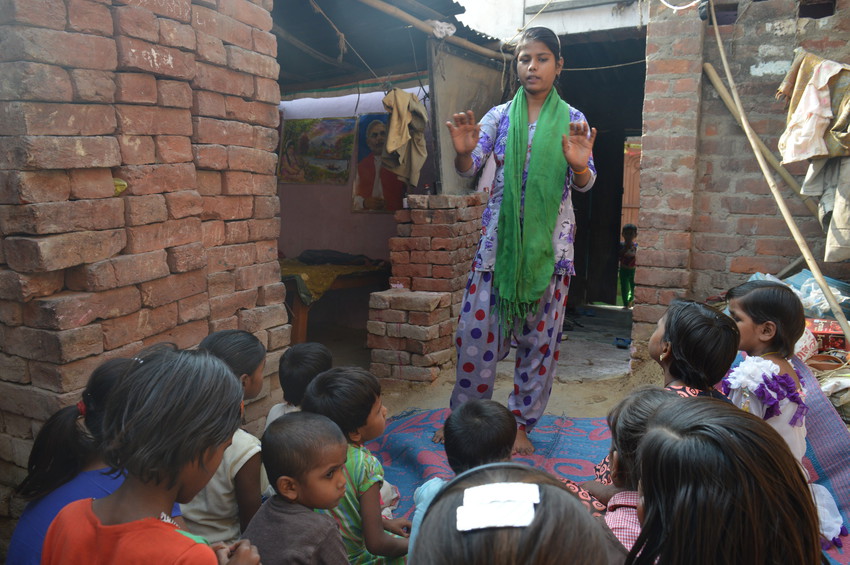Site will be
unavailable for maintenance from June. 4, 11:30 p.m., to June 5, 12:30 a.m. ET. Thank you for your
patience!
Community-led Child Protection Drives ChildFund’s COVID-19 Response
Posted on 11/11/2020
Betsy Sherwood, MSW & Sr. Advisor Child Protection
The devastating impact of the COVID-19 pandemic on children around the world cannot be overstated. At the start of the crisis, many governments moved swiftly to enact rules aimed at slowing the spread of the virus – but in doing so, they also halted critical prevention and response services designed to protect children from threats such as economic instability, lack of health care and violence, sparking a parallel crisis in many homes and communities.
The work we do at ChildFund is built upon the intimacy of social connection. Through a hyper-localized approach, working through hundreds of local partners, we are able to reach 13.6 million children and family members in their homes, schools, and communities in 24 countries worldwide. The loss of this intimacy due to the pandemic is being felt acutely by staff and families alike, creating an unprecedented challenge to ensuring that the children we care for can thrive even in these difficult times.
At the start of the pandemic, we worked to swiftly address children’s immediate needs, including food insecurity, family economic instability, social and emotional stress, and education and social services disruption. These needs were, and remain, urgent. However, through our hyper-local approach, ChildFund has been able to quickly pivot programming under these extraordinary circumstances, especially where community-based child protection mechanisms have already been integrated. And as we all move into a “new normal” of pandemic life, we continue to reach children and families who need assistance at ever-growing numbers.

ChildFund Kenya staff member Ann Kanini shares resources about positive
parenting as part of a home visit during the COVID-19 crisis.
Child Protection Programs Allow Rapid Response to COVID-19
In recent years, ChildFund has invested heavily in strengthening Community-Based Child Protection (CBCP) -- community-level networks or groups of individuals who work through formal and informal structures to promote safer environments for children. Through the CBCP, our local partners have been able to conduct highly contextualized, participatory research through mapping – a process that involves collecting information about a community’s assets and resources. This data has been used since well before COVID-19 to better understand children’s and youth’s unique needs, to craft relevant community-driven activities, and to inform policy advocacy work.
With the onset of the pandemic, the insights generated from CBCP research allowed communities to quickly refocus their child protection programming. Before COVID-19, 330 areas had completed CBCP mapping, allowing local leaders to have their finger on the pulse of their communities, enabling them to quickly identify the most at-risk populations as the crisis closed in. In fact, existing child protection groups at all levels were able to conduct rapid assessments and to gather innovative ideas so that we could continue serving children and families under these unprecedented circumstances.
Brazil has been hit particularly hard by COVID-19, with more than 5.2 million cases and 153,000 deaths to date* – numbers that are only surpassed currently by India (reported cases) and the United States (reported deaths). Child protection specialists there have been using every possible opportunity to mainstream messages about child protection risks and ways of reporting into their programming, which has primed them to respond to the pandemic. Karla Correa, a Child Protection Specialist with ChildFund Brazil, explains, “It is evident that in the communities where we have taken the time to develop child protection plans, there is fundamentally a better understanding of the risk and protective factors among the children in their communities.” Now during COVID-19, partners in these areas can make more targeted and impactful interventions for households most at risk.
And because of our ability to respond to the ever-changing programming dynamics brought on by the pandemic, other urgent needs of children in our programs are still being met. In Zambia, cases and total deaths reported have been relatively low, but government restrictions have still been put in place that can potentially limit interactions and response times within program areas. However, according to Chimuka Hamusunse, ChildFund Zambia Child Protection Specialist, our community-based approach has enabled us to continue working with community and district networks to identify and report any issues, such as cases of child abuse, as quickly as possible.
“Despite the COVID-19 travel restrictions, our community networks in Zambia, who also act as child protection advocates, have continued working in small teams to ensure that cases of violence against children are monitored and services are received,” says Hamusunse. “Their lines of communication with support from ChildFund have remained open, and overall, even in the face of the crisis, key actors are very well-informed about the issues of protection at district and community levels.”
These community-based approaches allow us to both respond efficiently to COVID-19 while also continuing to address the underlying child protection needs that we are committed to combatting.

In February 2019, a peer educator talks to a group of youth and parents about
the
dangers of early marriage as part of ChildFund’s child protection programming in Zambia.
Even now that the COVID-19 crisis has suspended most in-person meetings, ChildFund’s
community networks in Zambia are still working in small teams to monitor cases of
violence
against children. Photo by Jake Lyell.
Innovation and Decisive Leadership Bolster Pandemic Response
During the onset of the crisis, we had a strong organizational commitment to make a hard pivot of our work and quickly, safely, and effectively roll out cash assistance programs in as many of our communities as possible, which would bring immediate financial relief to families who needed it. During the planning phase, we leveraged our partner organizations so that we could create targeted, unique responses in each of the communities involved. Through this approach, we have been able to reach more than 125,000 families to date with cash assistance of just over 4.3 million dollars.
Children in our programs have also played an integral role in promoting their own protection. Through an innovative local partner-led initiative in India’s Firozabad district, members of the Village Child Protection Committees trained children and youth as local reporters to safely document stories about emerging child protection issues based on their experiences during the early days of COVID-19. India ranks second in COVID-19 infections, currently at 7.5 million, and has reported more than 115,000 deaths*.
Gujeet Rawat, Child Protection Specialist for ChildFund India, says, “The stories documented were shared with community leaders and key government stakeholders to highlight the need for action. The stories were powerful, the messages were clear, and we are seeing the impact of placing children at the center of identifying and asking for what they need to feel safer and better protected.”
In one case, for example, one group of such reporters petitioned the mayor of their village to open the local primary school, because many out-of-school children were turning to bangle-making, a dangerous occupation, especially for young children. Not only did the program help to organically identify the specific struggles families in the community were facing under the weight of the pandemic, but it also helped to build children’s confidence and problem-solving abilities. Sonal**, a 9th-grader, said, ‘’Ever since I became a child reporter, I started talking openly. Earlier I was very afraid to talk to anyone and now I can take [the] initiative to solve the problems of myself and my community. My self-confidence has increased, and now I can [m]ake decisions on my own.” Sonal’s experience personifies ChildFund’s strong organizational commitment to listening to the voices of children and youth, especially in times of crisis.

Shakuntala, a former child laborer in the infamous bangle-making industry, speaks
to children about child labor during a meeting of the Village Child Protection
Committee
in Firozabad, India, in 2017. Children and youth in ChildFund’s
programs are always encouraged
to play a role in promoting their own protection.
More Connection, Greater Opportunity to Effect Change
Before COVID-19, the opportunity for colleagues across regions to collaborate and share data insights, formally or informally, was unfortunately rare. These days, however, with the necessity for most staff to work virtually, we are more connected than ever. Even with the challenges of working from home and completely online, we have created a remarkable culture of sharing, exchanging, and learning from one another. In an average morning meeting, a colleague from South America asks for advice from a colleague in West Africa on how they approached adolescent girl programming in the face of Ebola. In the next beat, the same colleague from West Africa asks someone in Asia for their ideas on addressing online sexual abuse and exploitation of children and youth. Questions and advice volley back and forth and excited conversations spill over into the chat box as we work to wrap up the meeting. At the heart of these lively exchanges is the realization of how important it is to consult and learn from the communities we seek to serve, and to share that learning among the diverse regions where we work. We believe this will lead to even more efficient and rapid responses to children’s most pressing needs, throughout ChildFund’s reach.
Investing in CBCP truly hits at the heart of the Humanitarian-Development Nexus, giving us a deeper, more nuanced understanding of the communities we serve and stronger capacity to better meet their needs in emergency situations. As we all continue to sit in a place of uncertainty, the damaging effects of this pandemic on children and families seem certain. But it is conceivable that the lessons learned, such as increased data/mapping-driven programming and more cross-sectional and cross-country collaboration, will have a positive impact on how not only ChildFund, but other NGOs, donors, foundations, corporate partners and policy makers operate in the future. True and organic community-based child protection strengthening takes time to develop and works only if we create more seats at the table to ensure that a diverse and inclusive range of voices and ideas are heard.
Loading...


